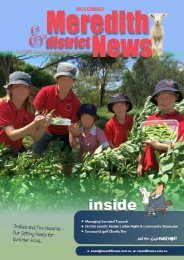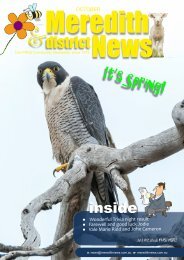March 2020 -web
You also want an ePaper? Increase the reach of your titles
YUMPU automatically turns print PDFs into web optimized ePapers that Google loves.
12 MEREDITH and DISTRICT NEWS
Steve Goat
Australia in the Frame
the unCultured
Goats
From March 7th 2020 through to May 3rd 2020, the
Geelong Art Gallery has a very special exhibition. The
Gallery is host to a wonderful collection of photographic
portraits called “The Look”. Over 60 images from the
National Portrait Gallery’s collection. More than half of
the 3000 images held in Canberra are photographs.
These are certainly memorable faces and images on
display: Heath Ledger, Megan Gale, Brian Brown, Gotye
AKA Wouter (Wal) Backer, and an amazing photo of
Gill Hicks, the spirited survivor of the 2005 London
bombing. These images manage to be windows into the
souls of the sitters, captured so well by master
photographers.
The Modern face of Geelong
While you are in our closest city, glance above street
level, and look up to the rising sky line. From the main
streets you will see many old facades of the boom
buildings of the late 19th/ early 20th century. But many
have undergone a face lift, or what is currently referred
to to as “Facadism”; where the shell or facade of the
building has been kept and new structures support, and
in many cases stand over the originals.
I don’t know about how you, the reader, feel about this
type of architecture. I find it interesting if not a little
disconcerting. What are we trying to preserve here?
What are we trying to project? Australia, being only
recently effected by British colonisation, has a short
European history. This architecture itself is a colonial
reworking of older classical styles from the northern
hemisphere. Is Geelong just another bland satellite city?
Have we built to suit our climate and heritage? Eastern
Beach has beautiful views to the You Yangs, but look
over your shoulder and you could be anywhere. The new
Malop Street layout is pedestrian friendly, but don’t look
up.
Not only have we reworked these sites, but we’ve done it
quite a lot. There are a disproportionate number of make
overs. Ballarat by contrast has preserved a much larger
number and proportion of older building. Have these
developments added to the quality of the streetscape? Or
have they created canyons of vacant small shopfronts
between the shiny glass and steel. There seem to be so
many tired and empty single-fronted old shops as well.
Some of the high rise examples are truly woeful. How do
you feel about it? The built environment should matter to
us. Just saying.............
PETE GOAT
This month I had a very rich cultural experience down in
the very green Otways.First was a performance, in Deans
Marsh, of “The Go-Between; Murranghurk William
Buckley”
by Jan “Yarn” Wositzsky . Most of us are familiar with
the story of Buckley, who escaped in 1803 from the
convict settlement that briefly existed at Sorrento and
then lived for 33 years with the Wadawurrung People,
until he encountered members of Batman’s party at
Indented Head in 1835.
The Wadawurrung accepted him as a “ngamadjidj”, the
spirit of a recently deceased clan member and gave him
the name Murrangurk.
Much of his time was spent along the coast between
Breamlea and Aireys Inlet, but he does relate coming up
the Moorabool as far as Ballark on occasions.
What Jan explores particularly in this show, in his
inimitable way with words, wit and music, is how
Buckley’s experience offered a unique opportunity to
minimise the conflict between the colonists with their
livestock, flooding in first from Tasmania and then
overland from north of the Murray, and the
Wadawurrung People.
With Buckley’s knowledge of Wadawurrung language
and culture the outcome could have been very different
from what had happened in Tasmania, that is a full on
frontier war. He was appointed Official Interpreter by
Commissioner Lonsdale and there was initially some
genuine attempt to achieve this.
However, it very soon became apparent to Buckley that
he was being used entirely to achieve the will of the
colonists to their maximum advantage and disillusioned,
he gave up his position and spent the rest of his life in
Tasmania. The Wadawurrung had been his family for the
greater part of his life and he could not face seeing them
so badly treated.
Interestingly, Governor Arthur said in hindsight that the
huge financial cost to the colonisers and the cost of life
to the Pelawa [Tasmanian Aboriginal Peoples] could
have been avoided if a Treaty like the Treaty of
Waitangi in New Zealand had been offered, with
adequate terms of compensation made.
Then next day I travelled with Jan to Qdos Arts at Lorne
where Professor Fred Cahir spoke about his new book
[which I first read about in The Meredith News last year]
“ My Country All Gone, The White Men Have Stolen
It : The Invasion of Wadawurrung Country 1800 - 1870
“
This was a natural follow-on after Buckley and Fred’s
book very comprehensively documents the events of this
period. Overwhelmingly it is a story of ruthless
dispossession but here and there are examples of
colonists who sought to help the Wadawurrung preserve
their culture, had great respect for them, admired their
knowledge and even tried to acquire it. A lot of this
knowledge comes through in the book.
In the audience was John Clark, a Gunditdjmara man
who responded with his wish, that if we are all going to
share this country, that we all need to understand it and
respect it in a spiritual and cultural way, not just
endlessly exploit it. We need to seek this knowledge.
Fred Cahir’s book is available from him at:
f.cahir@federation.edu.au
















